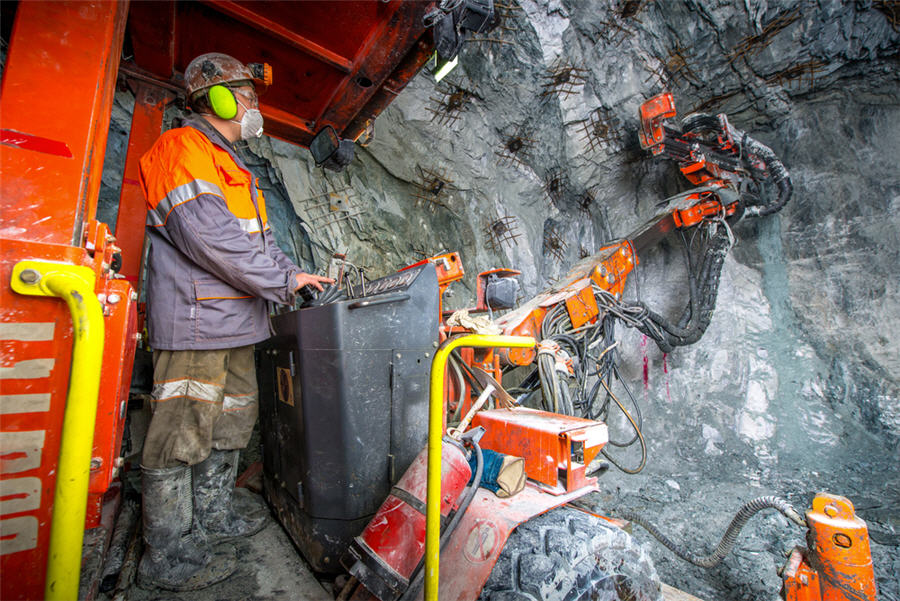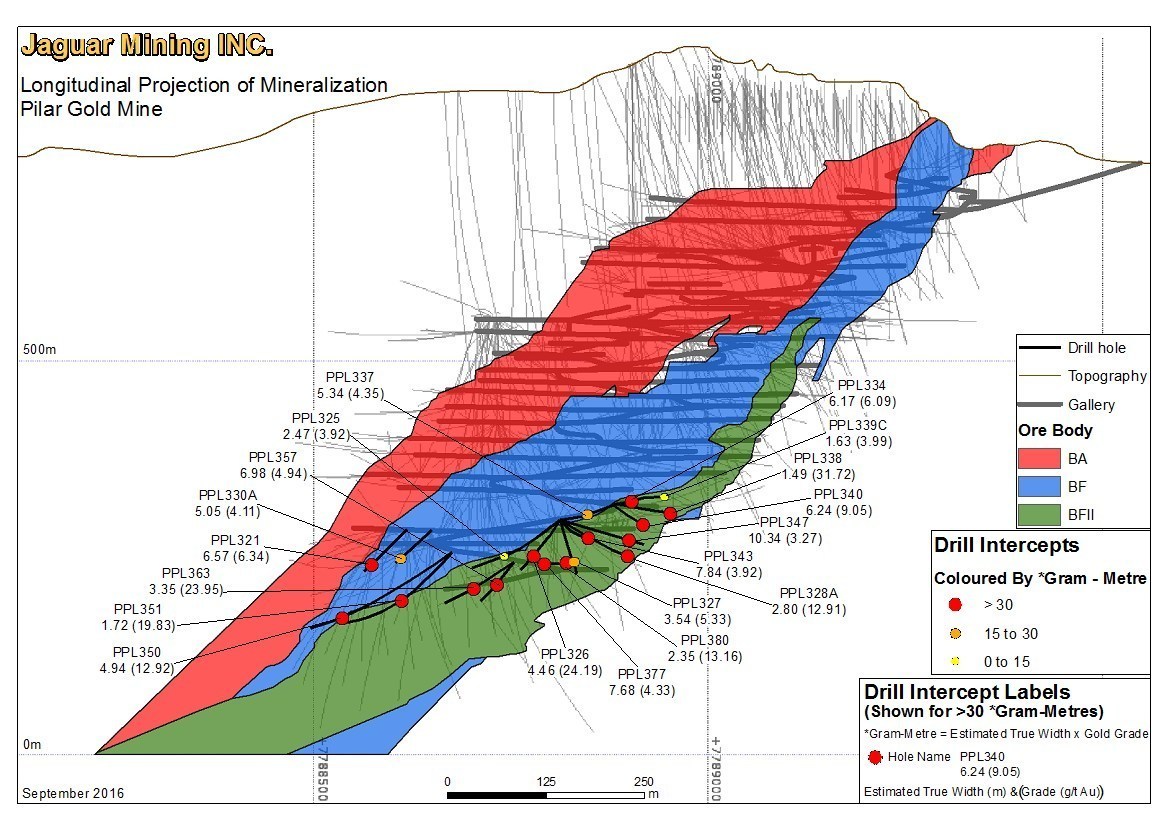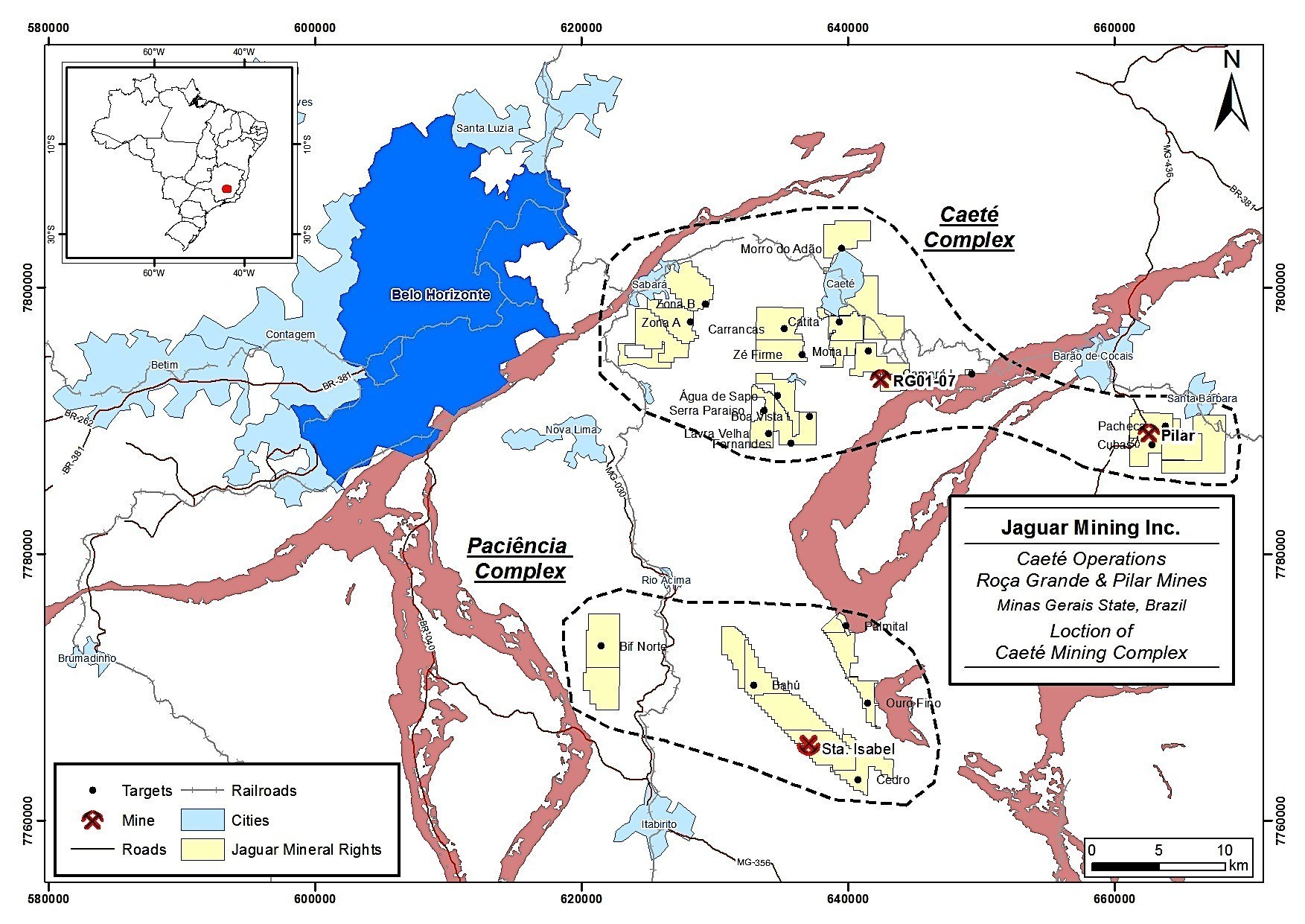Jaguar intercepts high-grade gold mineralization at Pilar Gold Mine

TORONTO, Sept. 26, 2016 /PRNewswire/ — Jaguar Mining Inc. (“Jaguar” or the “Company”) (TSX: JAG) is pleased to announce positive drill results from 40 underground diamond drill holes conducted at the Pilar Gold Mine (“Pilar”) located at the Company’s Caeté Complex in the state of Minas Gerais, Brazil. The Caeté Complex is situated in the Iron Quadrangle, one of the most prolific mining districts in South America. These results continue to reaffirm increasing grade profiles at depth at the Pilar BFII ore body and suggest a strong potential for the significant conversion of Mineral Resources to Mineral Reserves.
This drill program (5,369 metres (“m”)) included 40 holes, which generated multiple high-grade drill intercepts from Pilar including BFII, BF, BA, LFW, LHW, C, and SW ore bodies. The total cost of this exploration program was approximately $0.4 million. The underground resource definition-drilling program was designed to test the current resource envelope, and to test the down plunge extensions of the Pilar ore bodies. The drill program targeted, in particular, the newly discovered BFII ore body, as previously outlined in the “Technical Report on the Roça Grande and Pilar Operations, Minas Gerais State, Brazil,” a copy of which is available on the Company’s SEDAR profile at www.sedar.com.

Figure 1 – Longitudinal Section, Pilar Gold Mine indicating drilling locations (Not all drill locations have been projected on this section) (PRNewsFoto/Jaguar Mining Inc.)

Figure 2 – Caete Complex Location Map (PRNewsFoto/Jaguar Mining Inc.)
Drilling Highlights and Key Intercepts
- Underground definition drilling on the Pilar BFII ore body has returned significant high-grade mineralization. Key intercepts include:
- Hole FSB552A – 17.40 g/t Au over 6.80 m (6.46 m ETW1);
- Hole PPL325 – 7.73 g/t Au over 16.35 m (15.52 m ETW1);
- Hole PPL326 – 24.19 g/t Au over 5.65 m (4.46 m ETW1);
- Hole PPL363 – 23.95 g/t Au over 4.00 m (3.35 m ETW1); and
- Hole PPL340 – 9.05 g/t Au over 7.90 m (6.24 m ETW1)
1ETW – Estimated true width
- Exploration drilling focused on testing extensions to the Banded Iron Formation (“BIF”) ore bodies to assess the growth potential for Measured and Indicated Mineral Resources.
- Definition drilling focused on providing increased confidence and classification of the near-term mineral resources.
- The definition drilling programs are designed to replace current reserves being depleted from mining and will be added to the new 2016 Mineral Reserve and Mineral Resource model at year-end.
Rodney Lamond, President and Chief Executive Officer of Jaguar, stated: “Today’s reported high-grade intercepts continue to confirm a strong mineralized system down-plunge of current Mineral Reserves at Pilar, in particular the high-grade intercepts related to the newly discovered BFII ore body. These results provide excellent potential for higher grades, the increase of Mineral Resources, and the conversion to reserves for mining at Pilar. Additionally, we have been very pleased with our operations at Pilar where our average grade has steadily increased and we are on track to achieve our production guidance for 2016. For the balance of 2016, the underground exploration and definition drilling programs will be focused on mineral resource growth and resource conversion to reserves in order to grow sustainable gold production.”
Drill Programs
This latest completed drill program consisting of 40 holes, over 5,369 m, (Table 1 and Figure 1) was designed to test and convert the current mineral resource envelope, and to test the extensions of the Pilar ore bodies. In addition, drilling has focused on providing increased confidence and classification of the near-term Mineral Resources. The drill program continues to confirm the geological continuity of BIF ore bodies and high grades at depth. The Company expects to continue to test down-plunge continuity in the BFII, BF, and BA ore bodies with a dedicated drill program throughout 2016 and 2017, which will include approximately 5,000 m of diamond drilling to increase definition and confidence below Level 9.
The Company’s current assessment of the historical geological information and the rational use of state-of-the-art 3-D software have been an important contribution to the understanding of the gold emplacement and consequent target generation of new resource identification.
Pilar Gold Mine
The Pilar Mine is situated in the northeast portion of the Iron Quadrangle about 100 kilometres east of the city of Belo Horizontein Minas Gerais, Brazil. The Iron Quadrangle is one of the largest and most important mining and mineral districts in South America with historical production of over 50 million ounces of gold. Mining activities in the Iron Quadrangle have been ongoing since the late 1600s. A number of important and historical gold deposits, including those of AngloGold Ashanti and Vale, are located in the Iron Quadrangle and make up a significant contribution to Brazil’s gold production.
The deposit is hosted in a meta volcanic sedimentary sequence of the Rio das Velhas Greenstone Belt and the mineralization is located between a folded zone of BIF, which forms a local isoclinal syncline dipping to the southeast. The west limb of this syncline has a normal stratigraphic stacking and is called the SW limb and the inverted limb, at the east side, is called limb B. The regional axial plane foliation has general direction of NNE/SSW dipping to SSE.
Mineralized zones are classified according to the position of the mineralization relative to the major syncline, the morphological continuity, and the structural and mineralogical occurrence mode. The mineralization is divided from footwall to hanging wall in the SW, LFW, BFII, BF, LHW, BA, and C ore bodies.
The SW ore body matches with the west limb, SW, of the syncline. The LFW ore body consists of a mineralized lens of sericite-chlorite-carbonate-quartz schist present in the footwall of the inverted limb B. The mineralized zones BFII, BF, and BA are parasitic anticlines dipping to the SE, also in limb B of the major syncline. The C ore body is a group of mineralized lenses of sericite-chlorite-carbonate-quartz schist associated with the contact of the shear zone with the BIF at the hanging wall of limb B.
Qualified Person
Scientific and technical information contained in this press release has been reviewed and approved by Marcos Dias Alvim, BSc Geo., MAusIMM (CP), Project Development Manager, who is an employee of Jaguar Mining Inc., and is a “qualified person” as defined by National Instrument 43-101- Standards of Disclosure for Mineral Projects (“NI 43-101”).
Quality Control
Jaguar Mining continues to use a quality-control program that includes insertion of blanks, commercial standards, and duplicate core samples in order to ensure best practice in sampling and analysis.
NQ and BQ size drill core is sawn in half with a diamond saw. Samples are selected for analysis in standard intervals according to geological characteristics such as lithology and hydrothermal alteration contents. All diamond drill hole collars are accurately surveyed using a Total Stations instrument and down-hole deviations are surveyed using optical Reflex Maribor.
Mean grades are calculated using a variable lower grade cut-off (generally 2 g/t Au). No upper gold grade cut has been applied to the data. However, the requirement for assay top cutting will be assessed during future resource work.
Half of the sawed sample is forwarded to the analytical laboratory for analysis while the remaining half of the core is stored in a secure location. The drill core samples are transported in securely sealed bags to the Jaguar in-house laboratory located at the Caeté Mine Complex in Minas Gerais. Some samples are also sent for check assaying to the independent SGS Geosol Laboratory located in Vespasiano, Minas Gerais. The preparation and analysis are all conducted at the respective facilities, either at the Roça Grande Mine Laboratory in Caeté, Minas Gerais or at the SGS Geosol Laboratory in Vespasiano, Minas Gerais. The Caeté Mine Complex laboratory does not carry an ISO certification. The SGS Geosol Laboratory is ISO 9001 accredited. As part of in-house QA/QC, the Caeté Mine Complex laboratory inserts certified gold standards, blanks, and pulp duplicate samples.
For a complete description of Jaguar’s sample preparation, analytical methods, and QA/QC procedures, please refer to the “Technical Report on the Roça Grande and Pilar Operations, Minas Gerais State, Brazil,” a copy of which is available on the Company’s SEDAR profile at www.sedar.com.
About Jaguar Mining Inc.
Jaguar Mining Inc. is a Canadian-listed junior gold mining, development, and exploration company operating in Brazil, with three gold mining complexes, and a large land package with significant upside exploration potential from mineral claims covering an area of approximately 191,000 hectares. The Company’s principal operating assets are located in the Iron Quadrangle, a prolific greenstone belt in the state of Minas Gerais and include the Turmalina Gold Mine Complex (“Mineração Turmalina Ltda” or “MTL”) and the Caeté Gold Mine Complex (“Mineracao Serras do Oeste Ltda” or “MSOL”), which combined produce more than 90,000 ounces of gold annually. The Company also owns the Paciência Gold Mine Complex, which has been on care and maintenance since 2012. Additional information is available on the Company’s website at www.jaguarmining.com.
More News
Anglo starts talks with banks on possible De Beers IPO
Anglo is pursuing a dual-track process in its effort to exit De Beers by trying to find a buyer for the struggling business.
March 28, 2025 | 12:19 pm
PDAC JV video: Golden Pursuit preps for discovery at sub-Arctic Gordon Lake, CEO says
A program to scan archived core using AI and expand geophysical surveys on the Wooferine-Lynk Zones is set to start soon.
March 28, 2025 | 11:35 am
{{ commodity.name }}
{{ post.title }}
{{ post.excerpt }}
{{ post.date }}



Comments